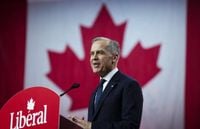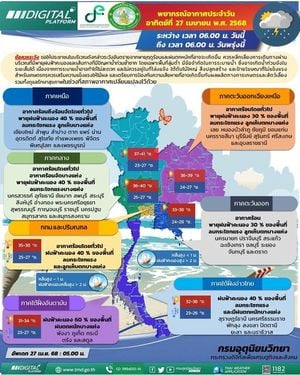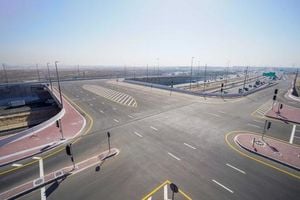With just over a week remaining in the federal election campaign, the Liberal Party of Canada has unveiled a bold new platform promising nearly $130 billion in new spending over the next four years. This announcement, made by Liberal Leader Mark Carney on April 19, 2025, marks a significant shift from the party's previous commitments under former Prime Minister Justin Trudeau, as it aims to address pressing national issues while projecting a path towards fiscal recovery.
The Liberal platform is structured around four key principles: unite, secure, protect, and build. Each principle outlines specific commitments that the party believes will resonate with voters. Among the highlights are $18 billion earmarked for defense spending and nearly $12 billion allocated for housing initiatives. Additionally, the platform includes $20 billion in counter-tariffs expected to be collected this year on American imports, reflecting the party's strategy to bolster Canada's economic resilience.
One of the most notable aspects of the Liberal plan is its acknowledgment of the current budget deficit, projected at $62.3 billion for this fiscal year. However, Carney assured that this deficit would decrease by nearly $15 billion, reaching approximately $48 billion by 2028-29. He stated, "Let's be absolutely clear, this is not a normal fall update, budget lockup. We are in the middle of the biggest crisis of our lifetimes. This is a plan that meets that moment in a way that is very prudent with peoples' hard-earned tax dollars but bold in terms of where this country can go."
In a parallel announcement, NDP Leader Jagmeet Singh also revealed his party's costed platform at a rally in Burnaby, British Columbia. Singh's plan includes significant tax reforms, a commitment of $7 billion over four years for mental health coverage, and a proposed wealth tax targeting individuals with over $10 million in holdings, which is expected to generate approximately $22 billion annually. The NDP's proposals would add $48 billion to the deficit over the same four-year period, according to their estimates.
Meanwhile, the Bloc Québécois made headlines earlier by releasing its own costed platform, which promises $133 billion in new federal spending over five years. Key components of their plan include a $22 billion wage subsidy related to the ongoing trade war with the United States and a $15 billion fund aimed at enhancing public transit. However, as the Bloc only runs candidates in Quebec, these commitments are primarily aimed at influencing the broader political landscape rather than being enacted independently.
As the election date approaches, the Conservative Party is also expected to unveil its fully costed platform in the coming days, adding to the dynamic political landscape as parties vie for voter support.
The Liberal platform outlines a comprehensive approach to various sectors, with a particular focus on housing and defense. Carney has pledged to double the pace of home building through the establishment of a new agency called Build Canada Homes (BCH), which will oversee the construction of affordable housing. This initiative is projected to cost approximately $3 billion annually over the next four years. Furthermore, the Liberal government aims to provide funding to municipalities to reduce development charges by half, costing an additional $1.5 billion each year during this period.
In terms of revenue generation, the Liberal platform anticipates increasing government revenues by $51.8 billion over four years, with a significant portion—$20 billion—expected from tariffs in 2025-26. Carney emphasized the need for caution regarding tariff revenue, stating, "We don't want to rely on those tariff revenues. Canada is not America, so you might see other parties who assume that's going to continue and that's going to be a source of revenue. That's a bad outcome for the country."
Additionally, the platform outlines plans to enhance tax penalties and fines through the Canada Revenue Agency (CRA), which is projected to bring in $3.8 billion over four years. The Liberal government also aims to achieve increased efficiency in government operations, targeting $6 billion in savings by 2026-27, with that figure rising to $13 billion annually by 2028-29.
On the immigration front, the Liberal platform proposes capping the number of non-permanent residents in Canada at less than 5 percent and limiting the annual growth of permanent residents to below one percent of the country's population. Carney stated that the previous government had allowed immigration levels to rise unsustainably, straining housing and social services. He asserted, "The government has a responsibility to those who come here to ensure that they have access to jobs, social services, and housing. If we cannot meet those responsibilities, we need to adjust the numbers until we get back on track."
These immigration reforms come in the wake of Canada welcoming over 430,000 new permanent residents in 2022, contributing to a historic population increase of 1.27 million in 2023. Critics argue that the rapid influx of newcomers has exacerbated the affordability crisis, while proponents maintain that immigration is essential for economic growth and filling job vacancies in critical sectors.
As the April 28 election date approaches, eligible voters are already casting their ballots, with advance polls open from 9 a.m. to 9 p.m. local time. The political landscape is charged as parties finalize their platforms and make their case to the electorate.
With significant promises made by the Liberals, NDP, and Bloc Québécois, the upcoming election is set to be a pivotal moment for Canadian politics, shaping the country’s fiscal future and addressing pressing social issues.







